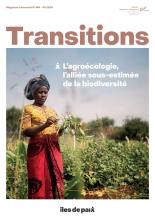Land Library Search
Through our robust search engine, you can search for any item of the over 73,000 highly curated resources in the Land Library.
If you would like to find an overview of what is possible, feel free to peruse the Search Guide.
/ library resources
Showing items 1 through 9 of 347.The Mekong Region has experienced rapid agrarian change over the past two decades, driven by public sector policies promoting agricultural commercialisation to alleviate rural poverty, provide income opportunities, and modernize agricultural production systems.
Dans les zones rurales, où l’agriculture est la principale source de subsistance, la terre est bien plus qu’une simple ressource économique ; elle est essentielle à l’identité et à la culture des communautés.
L’actualité de cet automne s’annonce exceptionnellement chargée sur les questions environnementales : les trois COP issues du Sommet de la Terre vont se réunir à quelques semaines d’intervalle, en commençant par la COP Biodiversité.
Les chiffres présentés dans la nouvelle publication sur la sécheresse en disent long sur l’urgence de s’attaquer à ce problème pressant. Pour lutter contre les effets négatifs de la sécheresse, la résilience mondiale à la sécheresse n’est pas une question de choix mais une nécessité.
This one-pager provides details on the LAND-at-scale project in Egypt. This project is implemented by GIZ Egypt, and financed by the Ministry of Foreign Affairs via the Netherlands Enterprise & Development Agency (RVO).
This study addresses the significant issue of land fragmentation in Ethiopia, which is characterized by small, irregular, scattered parcels with no or adequate road access.
China has achieved success in implementing the rural revitalization strategy and promoting the development of new urbanization.
Spatial planning systems and institutions have a significant role in managing non-agricultural land growth in Europe and the assessment of how their implementation impacts on agricultural land consumption is of great significance for policy and institutional improvement.
Urban forms are human-made systems that display a close connection with fractal objects, following organisation patterns that are not as random as believed. In this context, fractal theory can be seriously considered as a powerful tool for characterizing land-use planning.








